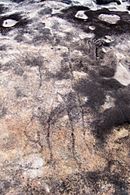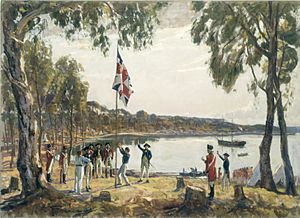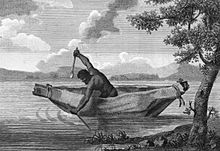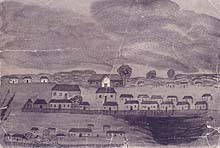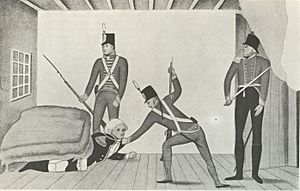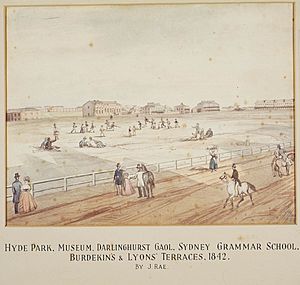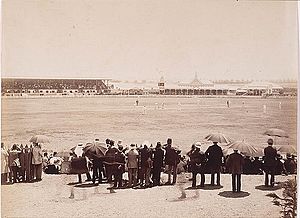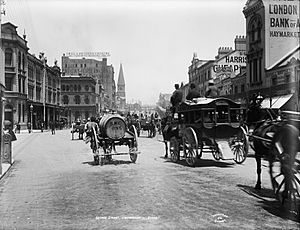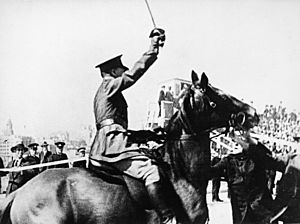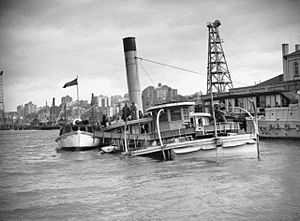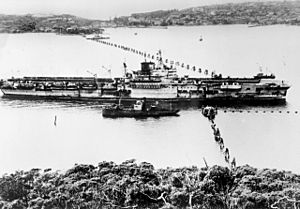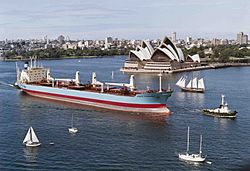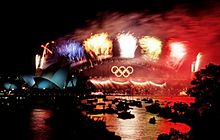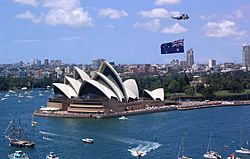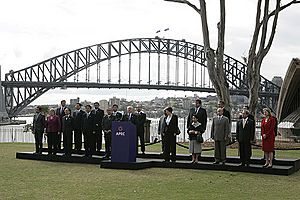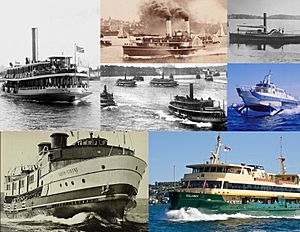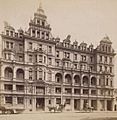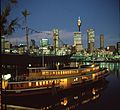History of Sydney facts for kids
The History of Sydney began long ago with the first people, the Aboriginal Australians. Their ancestors arrived in the Sydney area many thousands of years ago. The modern history of the city started in 1788. This is when British ships, known as the First Fleet, arrived. Great Britain then set up a colony here.
From 1788 to 1900, Sydney was the main city of the British colony of New South Wales. A city council was created in 1840. In 1901, Sydney became a state capital. This happened when New South Wales joined the Australian Federation. Today, Sydney is Australia's largest city. It is a big international hub for culture and money. Sydney has hosted many global events, including the 2000 Summer Olympics.
Contents
Ancient History: The First People
The first people to live in the Sydney area were Aboriginal Australians. Scientists believe they lived here for at least 30,000 years. Digs in Parramatta, Western Sydney, found charcoal and stone tools. These show Aboriginal people lived there a very long time ago. Near Penrith, even older tools were found. These tools suggest people were in Sydney 45,000 to 50,000 years ago. This means human settlement happened earlier than once thought.
Before the British arrived, between 4,000 and 8,000 Aboriginal people lived in the Sydney area. They belonged to about 29 different clans. The Cadigal clan lived around Sydney Cove. The main language groups were Darug, Guringai, and Dharawal. Early Europeans saw the local people camping and fishing. They used trees for bark and food. They also collected shells and cooked fish.
The area around Port Jackson (Sydney Harbour) was home to several Aboriginal tribes. The "Eora people" were the coastal Aboriginals of the Sydney district. The name Eora means "from this place." Local Aboriginal people used it to tell the British where they came from. The Cadigal band owned the Sydney city area. Their land stretched from South Head to Petersham.
These groups were the first to be affected when the British arrived. However, descendants of the Eora people still live strongly in Sydney today. Besides the Eora, people from the Dharug, Kuringgai, and Dharawal language groups lived in and around Sydney. Their history goes back thousands of years before the British First Fleet. You can still find Aboriginal stone tools and art in New South Wales. Some are even in modern Sydney, like in Ku-ring-gai Chase National Park.
How Great Britain Discovered Sydney
On April 19, 1770, the ship HMS Endeavour sighted Australia's east coast. It was led by Lieutenant James Cook. Ten days later, they landed at a bay in what is now southern Sydney. The ship's scientist, Joseph Banks, was amazed by the new plants and animals. Cook named the area "Botany Bay." Cook mapped the east coast. On August 22, he claimed the coast for King George III of Great Britain. Cook and Banks then told London that Botany Bay would be a good place for a British colony.
The British colony of New South Wales was set up in January 1788. This happened when the First Fleet arrived. It had 11 ships led by Captain Arthur Phillip. Over a thousand settlers came, including 778 convicts. A few days after arriving at Botany Bay, the fleet moved. They found a better spot at Port Jackson. A settlement was started at Sydney Cove on January 26, 1788. This day later became Australia's national day, Australia Day. Governor Phillip officially declared the colony on February 7, 1788.
Sydney Cove had fresh water and a safe harbour. Phillip called it:
'being without exception the finest Harbour in the World
Phillip first named the colony "New Albion." But for some reason, it became "Sydney." It was named after Lord Sydney, who was a British government official. He had approved Phillip to start the colony. Phillip also visited the Manly Cove area in January 1788. He was impressed by the local Aboriginal people. They were confident and brave. He named the cove Manly Cove.
Governor Phillip had full power over the colony. He wanted to have good relations with the Aboriginal people. He also tried to reform the convicts. Phillip and his officers wrote journals about the hard times in the first years. They often worried about Sydney's future. Early farming was difficult. Supplies from overseas were hard to get.
Between 1788 and 1792, about 3,546 male and 766 female convicts arrived. Many were not skilled for building a colony. Many new arrivals were sick or unfit for work. Healthy convicts also got worse from hard labour and poor food. The food situation became very bad in 1790. The Second Fleet arrived in June 1790. A quarter of its "passengers" had died from sickness. The condition of the Third Fleet convicts shocked Phillip. But from 1791, more ships arrived regularly. Trade also began. This helped reduce the feeling of being alone and improved supplies.
Phillip sent teams to find better farming land. He found the Parramatta region promising. He moved many convicts there from late 1788. This became the main economic centre of the colony. Sydney Cove remained an important port and social hub. Poor tools and unfamiliar soil and climate made farming hard. But building work, helped by convict labour, moved forward steadily.
Impact on Sydney's First People
European settlement greatly affected the local Aboriginal people. At first, this was mainly because their food sources were used up. Also, new diseases like smallpox arrived. Aboriginal people had no natural protection against these diseases. Many died in large numbers. Governor Phillip actually had strict rules for settlers. He wanted them to treat native people well. This was very advanced for his time. However, in April 1789, a terrible smallpox disease spread. It killed hundreds of Eora people and nearby groups.
Watkin Tench, a First Fleet officer, wrote about the early colony. He thought the disease might have come from Aboriginal people disturbing a French sailor's grave. This sailor had died shortly after arriving. But Tench also wrote that he never heard of smallpox among the French sailors. Another idea was that the colony's doctors had brought smallpox-infected material from England. They used it for vaccinations.
Historian Judy Campbell believes the First Fleet was not the source. She says smallpox was not on any First Fleet members. She points to fishing fleets from Indonesia. Smallpox was common there. These fleets regularly met Aboriginal people in Australia's North. This was a more likely source. Other historians think it came from the First Fleet. This topic is much debated. A 2014 review by Christopher Warren suggested British marines might have spread smallpox. Governor Phillip might not have known.
Between 1788 and 1792, convicts and their guards were most of the population. But in one generation, a group of freed convicts grew. They could be given land. These people started Sydney's private economy. Soldiers whose service ended also joined them. Later, free settlers began arriving from Britain. Governor Phillip left the colony for England on December 11, 1792. The new settlement had survived near starvation and great isolation for four years.
Aboriginal Resistance and Conflicts
As Europeans settled, much land was cleared for farming. This destroyed Aboriginal food sources. New diseases like smallpox also arrived. These things made Aboriginal clans angry at the British. This led to violent fights.
Pemulwuy, an Aboriginal leader, is famous for fighting against European settlement. He convinced the Eora, Dharug, and Tharawal people to join him. From 1792, Pemulwuy led attacks on settlers. These attacks happened in areas like Parramatta, Georges River, and Hawkesbury River. He often burned crops and killed farm animals. Historians debate if Pemulwuy was actively fighting settlement or upholding Aboriginal law. Aboriginal law often involved revenge. But the British saw his attacks as acts of war.
In March 1797, Pemulwuy led about 100 Aboriginal warriors. They attacked a government farm at Toongabbie. The next morning, government troops and settlers followed them to Parramatta. Pemulwuy threw a spear at a soldier. The troops and settlers then fired their guns. Pemulwuy was shot and wounded first. The Aboriginal warriors threw many spears, hitting one man. The British had much stronger weapons. Five Aboriginal warriors were killed quickly. This event is now known as the Battle of Parramatta.
The Hawkesbury and Nepean Wars (1795–1816) were a series of fights. They were between Great Britain and the Aboriginal clans of the Hawkesbury and Nepean Rivers. These wars were complex. Many Aboriginal groups sometimes helped the British to gain land. Then they would fight against the British again. The fighting mostly used guerrilla tactics (small, surprise attacks). But some larger battles also happened. The wars ended with the defeat of the Hawkesbury and Nepean Aboriginal clans. They then lost their lands.
Sydney Town: Early Days
Early Sydney was shaped by the hard times settlers faced. In the first years, drought and disease caused many problems. But the situation soon got better. The military government relied on the army, called the New South Wales Corps. They were also known as the "Rum Corps" because they controlled alcohol imports.
Life for convicts in the colony was very tough. In 1804, Irish convicts led the Castle Hill Rebellion. Fights happened between the governors and the Rum Corps officers. Many officers owned land, like John Macarthur. In 1808, these fights turned into an open rebellion. This was the Rum Rebellion. The Rum Corps removed Governor William Bligh. He was famous from the mutiny on the Bounty.
The New South Wales Corps was formed in England in 1789. They were meant to replace the marines who came with the First Fleet. Officers of the Corps soon got involved in the profitable alcohol trade. In the 1808 Rum Rebellion, the Corps worked with wool trader John Macarthur. They took over the government. This was the only successful armed takeover in Australian history. It led to a short period of military rule. Governor Lachlan Macquarie arrived from Britain in 1810.
Macquarie was the last strong governor of New South Wales, from 1810 to 1821. He played a big part in Sydney's growth. He helped it change from a convict colony to a free society. He built public works, a bank, churches, and charities. He also tried to have good relations with Aboriginal people. In 1813, he sent explorers across the Blue Mountains. They found the great plains inside Australia. Macquarie's main policy was how he treated freed convicts. He said they should be treated as equals to free settlers. Against opposition, he appointed freed convicts to important government jobs. For example, Francis Greenway became colonial architect. William Redfern became a magistrate. London thought his public works were too expensive. Society was shocked by how he treated freed convicts.
Governor and Mrs. Macquarie liked the clean air of rural Parramatta. They found Sydney Town dirty and full of crime. They turned Old Government House, Parramatta, into an elegant English-style home. This building was first built in 1799. It showed how important the Parramatta area was for the economy. Today, it is Australia's oldest public building. UNESCO made it a World Heritage site in 2010.
Gold Rush and Economic Growth
Australia had several gold rushes in the mid-1800s. The first gold was found in Bathurst, west of Sydney, in 1851. Many immigrant miners came to Sydney. The population grew from 39,000 to 200,000 people in 20 years. More people and economic activity meant more infrastructure was needed. This led to big improvements in the city's railway and port systems in the 1850s and 1860s. Many Chinese people also arrived, leaving their indentured work.
After a fast growth period, more gold was found in Victoria. This drew new residents away from Sydney towards Melbourne. A big rivalry started between the two cities. This rivalry became very strong when Australia decided to become a federation. Both Melbourne and Sydney wanted to be the capital city. The dispute was settled by creating a new city, Canberra, instead.
Political Development
The first government in Sydney after 1788 was run by an appointed governor. This was an autocratic system, meaning one person had all the power. However, English law came with the colonists. This meant ideas about rights from the Magna Carta (1215) and the Bill of Rights (1689) were brought to Australia. People started asking for a government where they could choose their leaders soon after the colonies were settled.
Australia's oldest law-making body, the New South Wales Legislative Council, was created in Sydney in 1825. It was a group of appointed people who advised the Governor. The northern part of Macquarie Street's Rum Hospital was used as the first Parliament House in 1829. It was the biggest building available in Sydney then.
William Wentworth started the Australian Patriotic Association in 1835. This was Australia's first political party. It demanded democratic government for New South Wales. John Plunkett, a reformist attorney general, wanted to apply new ideas to governing the colony. He worked to make everyone equal before the law. He gave jury rights to freed convicts. He also gave legal protection to convicts, servants, and Aboriginal people. He made Anglicans, Catholics, Presbyterians, and Methodists legally equal.
In 1838, Caroline Chisholm arrived in Sydney. She was a famous humanitarian. She soon began helping poor women who had migrated. She met every immigrant ship at the docks. She found jobs for immigrant girls. She also set up a Female Immigrants' Home. Later, she campaigned for legal changes to help poor people. She also worked to help female immigration and family support in the colonies.
In 1840, the Sydney City Council was set up. Men who owned property worth 1,000 pounds could run for election. Wealthy landowners could have up to four votes each. Australia's first parliamentary elections were held for the New South Wales Legislative Council in 1843. Voting rights (for males only) were still linked to owning property or having money. The Sydney Incorporation Act in 1842 officially recognized the settlement as a town. It also set up a management structure for its administration.
The first elected officials met in public houses. But they started campaigning for a civic hall. They chose the old Sydney cemetery site on George Street. This was in the city's business heart. They arranged for Sydney’s first royal visitor, Prince Alfred, to lay a foundation stone on April 4, 1868. This was even before the government approved the plan. That same year, a design for the Sydney Town Hall was chosen. It was inspired by the French Hotel de Ville de Paris. To this day, the Hall is the office of the Lord Mayor of Sydney and the City Council.
Convict transportation ended. The population grew fast after the Australian gold rushes. This led to more demands for "British institutions" in New South Wales. This meant an elected parliament and responsible government. In 1851, more people could vote for the Legislative Council. In 1857, all male British subjects 21 years or older in New South Wales got the right to vote. From the 1860s, government in New South Wales became more stable and secure.
Cultural Development
During the 1800s, Sydney built many of its main cultural places. Governor Lachlan Macquarie wanted Sydney to have grand public buildings. He started the Royal Botanic Gardens. He set aside Hyde Park for people to relax and for troops to exercise.
Macquarie saved a large area for an Anglican Cathedral. He laid the first stone for St Mary's Catholic Cathedral in 1821. St Andrew's Anglican Cathedral also began construction later. After a fire and delays, the current St Mary's Catholic Cathedral's foundation stone was laid in 1868. It became a tall gothic-style landmark.
The first Sydney Royal Easter Show, an agricultural exhibition, began in 1823. Alexander Macleay started collecting items for Australia's oldest museum, the Australian Museum, in 1826. The current building opened in 1857. The University of Sydney was started in 1850. The Royal National Park, south of the city, opened in 1879. It was the second national park in the world.
An art academy formed in 1870. The current Art Gallery of New South Wales building began construction in 1896. Artists' camps formed around Sydney Harbour in the 1880s and 1890s. These were inspired by French impressionism. They were in beautiful places like Balmoral Beach and Curlew Camp. Artists like Arthur Streeton and Tom Roberts worked here. They created important Australian paintings.
Australia's first rugby union club, the Sydney University Football Club, was founded in Sydney in 1863. The New South Wales Rugby Union started in 1874. An annual club competition began in Sydney that year. Rugby was very popular at first. But in 1907, the New South Wales Rugby League was formed. It grew to be the city's favourite football game. In 1878, the first major cricket match at the Sydney Cricket Ground was played. It was between New South Wales and Victoria. The Athletic Association of the Great Public Schools of New South Wales (A.A.G.P.S) was set up in Sydney in 1892. Interschool rugby and athletics competitions began that year. Cricket and rowing followed the next year.
The Sydney International Exhibition of 1879 showed the colonial capital to the world. Some items from this event became the first collection of the new Technological, Industrial and Sanitary Museum of New South Wales (now the Powerhouse Museum).
Many grand public buildings were built in the 1800s. The Queen Victoria Building (QVB) was finished in 1898. It was designed by George McRae. It stands on the site of the old Sydney markets. It was built to honour Queen Victoria. Its construction helped employ stonemasons, plasterers, and artists during a tough economic time. The building was restored later. Today, it is a shopping and dining hall. Sydney's old buildings, especially Victorian terrace houses, are like parts of London.
Sydney's first newspaper was the Sydney Gazette. It was started and run by George Howe. It came out sometimes between 1803 and 1842. It is a valuable source of information about the colony's early days. The Sydney Morning Herald became a daily newspaper in 1831. It is still published today. Two Sydney journalists, J. F. Archibald and John Haynes, started The Bulletin magazine. The first issue came out on January 31, 1880. It was meant to be about politics and business, with some stories. It was radical and nationalist at first. It became very influential. It was a famous place for Australian writers and cartoonists to publish their work. These included Henry Lawson, Banjo Paterson, and Norman Lindsay.
The 20th Century
Federation, World War I, and the Great Depression
On January 1, 1901, the Commonwealth of Australia began. Sydney stopped being a colonial capital. It became the capital of the Australian state of New South Wales. With new industries, Sydney grew fast. By the early 1900s, its population was over one million.
After the Victorian Era, Sydney's character began to change. In the 1800s, Sydney's beaches were popular holiday spots. But swimming in the sea during the day was seen as improper until the early 1900s. In October 1902, William Gocher went into the water at Manly Beach. He wore a neck-to-knee swimsuit. Police made him leave. But the next year, Manly Council allowed all-day swimming. People still had to wear neck-to-knee suits. Sydney's love for sun and surf grew. The world's first surf lifesaving club started at Bondi Beach in 1906. In 1915, Duke Kahanamoku from Hawaii showed surfboard riding at Freshwater Beach. He amazed locals and started Australia's long love for the sport.
Australia joined World War I in 1914, helping Great Britain. 60,000 Australian troops died. This deeply affected the small nation. After the war, Martin Place was chosen for the Sydney Cenotaph. This monument honours the dead. It is still a focus for ANZAC Day events in the city. The city's main war memorial, the ANZAC War Memorial, opened in Hyde Park in 1934. In the city's cultural life, the first Archibald Prize was given in 1921. This is now Australia's most important portrait prize. It came from a gift by J. F. Archibald, an editor. The Art Gallery of New South Wales manages it. It is given for "the best portrait, preferably of some man or woman distinguished in Art, Letters, Science or Politics." Sydney's grand Capitol Theatre opened in 1928. After being restored in the 1990s, it is still one of the nation's best theatres.
In a cricket match at the Sydney Cricket Ground in 1930, Don Bradman made history. He was a young man from New South Wales, just 21 years old. He broke the record for the highest score in first-class cricket with 452 runs not out. He did this in just 415 minutes. Bradman later played for South Australia. His amazing performances brought much-needed joy to Sydney residents during the Great Depression.
The Great Depression hit Sydney hard. But one bright spot was the completion of the Sydney Harbour Bridge in 1932. This famous landmark connects Sydney's northern and southern shores. It started being built in 1924. It took 1,400 men eight years to build. It cost £4.2 million and used 53,000 tonnes of steel. It had six traffic lanes, two train lines, and two tram tracks. Sixteen workers died during its construction. There was a toll to cross the bridge. It cost a horse and rider three pence, and a car six pence. In its first year, about 11,000 vehicles crossed it daily. By the early 2000s, this number was around 160,000 vehicles per day.
Jack Lang, the Labor Premier of New South Wales, was supposed to open the bridge. He was to cut a ribbon at its southern end. But just as Lang was about to cut the ribbon, a man in military uniform rode in on a horse. He cut the ribbon with his sword. He declared the bridge open for the people of New South Wales before the official ceremony. He was quickly arrested. The ribbon was quickly tied again, and Lang did the official opening. The uninvited ribbon cutter was Francis de Groot. He was part of a group called the New Guard. They were against Lang's policies. They were also upset that a member of the Royal Family had not been asked to open the bridge.
With high unemployment and growing state debt, Premier Jack Lang had arguments with the federal government. He also argued with foreign lenders. He was removed from his position by the Governor in 1932.
The 1938 British Empire Games were held in Sydney from February 5–12. This was to celebrate Sydney's 150th birthday since British settlement.
World War II
On September 3, 1939, Prime Minister Robert Menzies announced Australia was joining World War II. This was broadcast on all radio stations. Sydney residents fighting in the Australian Armed Forces served in Europe, the Mediterranean, and North Africa. They fought against Nazi Germany and Fascist Italy. They also fought against Imperial Japan in South-East Asia and other parts of the Pacific.
Japan entered the war in December 1941. Singapore fell in February. Japan took over much of South East Asia and large parts of the Pacific. In response, the Australian government made the army and air force bigger. They changed economic, home, and industry rules to support the war. Sydney saw a big increase in factories to meet war needs. Unemployment also disappeared. Not enough workers meant the government had to let women do more active war work.
After starting their Pacific War, the Imperial Japanese Navy entered New South Wales waters. In late May and early June 1942, Japanese submarines made daring attacks on Sydney and Newcastle. On the night of May 31–June 1, 1942, three small submarines were launched. They came from larger "mother" submarines east of Sydney. They entered Sydney Harbour to attack ships. Their main targets were the cruisers USS Chicago and HMAS Canberra.
The first small submarine entered the harbour at 8 pm. The third got caught in the harbour's anti-submarine net. One submarine reached Potts Point. Under fire, it fired two torpedoes at the US cruiser Chicago. It missed the target. One torpedo hit the sea wall where the ferry HMAS Kuttabul was docked. The explosion sank the Kuttabul. 19 Australian and 2 British naval personnel sleeping on board were killed.
After the attack, the Harbour's defences were made stronger. Australians feared a Japanese invasion. The bodies of the four Japanese submariners were cremated with full military honours. They were sent back to Japan. Eight days after the first attack, two large "mother" submarines offshore fired shells at Sydney and Newcastle. This caused little real damage. The goal was to make the city's people feel uneasy. Some Sydney residents moved away from the coast. Others dug air raid shelters in their backyards. Membership in volunteer defence groups grew to over 80,000.
The main Japanese naval advance towards Australia was stopped. This happened with the help of the United States Navy in May 1942. This was at the Battle of the Coral Sea. By the end of 1943, Japan had stopped submarine operations in Australian waters.
Post-War Sydney
After World War II, the Australian government started a large immigration program. People from many different cultures came. Sydney's population grew. It also became more culturally diverse. New industries like information technology, education, finance, and arts grew.
During the post-war period, Sydney became a stronger education centre in the Western Pacific. Five new universities were built. They met the needs of a growing population and demand for education. These included the University of New South Wales and the University of Technology, Sydney.
Since the 1970s, Sydney has changed rapidly in its economy and society. Air travel replaced shipping. Most new migrants to Australia arrived in Sydney by air. As a result, the city became a mix of many cultures.
A new skyline of concrete and steel skyscrapers replaced much of old Sydney. The Australia Square Tower, built in 1967, became a city landmark. It was designed by Harry Seidler. In 1981, Sydney Tower became the tallest building at 305 metres. By the late 1960s, bulldozers were threatening The Rocks. This was Sydney's oldest European area. It was saved only by public protests. These protests aimed to keep 'working class housing' near the city centre. This also saved many old buildings. In 1973, after long planning, the Sydney Opera House officially opened. It was designed by Jørn Utzon. It became a symbol of Sydney and Australia. UNESCO listed it as a World Heritage site in 2007.
Many influential people came from Sydney during this time. These included feminist Germaine Greer and author Clive James. Artist Brett Whitely also rose to fame. Paul Hogan went from painting the Sydney Harbour Bridge to being a TV star. Then he became a global film star with "Crocodile" Dundee in 1986. This film starts with scenes of Sydney. Theatre groups like the Sydney Theatre Company helped actors like Mel Gibson and Cate Blanchett start their careers. Nicole Kidman and Russell Crowe also began their careers in the city. In 1998, Fox Studios Australia opened as a major movie studio. It was built on the old Sydney Showground site. It produced big movies like The Matrix films and Moulin Rouge!. The traditional Sydney Royal Easter Show moved to the New Sydney Showground at Homebush.
To ease traffic on the Sydney Harbour Bridge, the Sydney Harbour Tunnel opened in August 1992. This 2.3-kilometre underwater tunnel cost A$554 million. It was built to withstand earthquakes and sinking ships. In the early 2000s, it carried about 75,000 vehicles a day.
Sydney usually has a mild climate. But in 1993-94, it had a serious bushfire season. This caused damage even in urban areas.
Olympic City and the New Millennium
Stadium Australia, also known as ANZ Stadium, was finished in March 1999. It is in the Sydney Olympic Park area. It cost A$690 million. It was built for the 2000 Summer Olympics. Sydney gained global attention in 2000 by hosting the Summer Olympic Games. The Opening Ceremony showed Australian history through dance. Aboriginal athlete Cathy Freeman lit the torch. At the Closing Ceremony, the President of the International Olympic Committee, Juan Antonio Samaranch, said:
"I am proud and happy to proclaim that you have presented to the world the best Olympic Games ever."
The Olympic mayor, Frank Sartor, was the Lord Mayor of Sydney from 1991 to 2003. His successor, Lucy Turnbull, was the first woman to hold that job in 2003. She was followed by Clover Moore, who has been Sydney's longest-serving Mayor since 2004. From 1991 to 2007, Sydney residents were Prime Minister of Australia. First Paul Keating, then John Howard. Later, Tony Abbott and Malcolm Turnbull also served. Sydney has kept strong political, economic, and cultural influence over Australia. It has also gained international fame in recent decades. After the Olympics, the city hosted the 2003 Rugby World Cup. It also hosted the APEC Leaders conference in 2007 and Catholic World Youth Day in 2008. Pope Benedict XVI led the World Youth Day event.
Sydney is known for its diversity. Most experts believe its population will keep growing. The city's first special rapid transit system is being built now. It is set to finish in 2019. The Sydney Metro will connect Epping to north-west Sydney. This will be a first for Australian transport. No other Australian city has an underground metro system like it.
Transport in Sydney
Ferries
Ferries have been very important for Sydney's transport and economy. Before the Sydney Harbour Bridge opened in 1932, Sydney had the world's largest ferry fleet.
From the first European settlement in Sydney Cove, boats ran along the Parramatta River. They served Parramatta and farms along the way. By the mid-1830s, regular services began. From the late 1800s, the North Shore grew fast. A train line took ferry passengers from Milsons Point up to Hornsby. Without a bridge, more and more steamers carried people across the harbour. In the early 1900s, Sydney Ferries Limited was the biggest ferry operator in the world.
The Manly ferry service is perhaps the most famous. Its large, ship-like ferries cross the open waters of the Sydney Heads. From the mid-1800s, the Port Jackson and Manly Steamship Company ran services. They took commuters and weekend visitors to the beach suburb of Manly.
The opening of the Sydney Harbour Bridge in 1932 changed Sydney Harbour forever. Sydney Ferries Limited's yearly passenger numbers dropped from 40 million to 15 million almost instantly. The tough times of the Great Depression and World War II slowed the ferries' decline. But by 1951, the NSW State Government had to take over the struggling Sydney Ferries Limited. The Port Jackson company did better. Their best year was 1946. After that, a slow decline led to the NSW State Government taking them over in the 1970s. Ferry operations became private in 2015. But the boats and facilities are still owned by the public.
Trams
Sydney once had Australia's largest tram system. It was the second largest in the British Commonwealth (after London). It was also one of the largest in the world. It was used very heavily. About 1,600 trams were in service at its busiest time in the 1930s.
Sydney's first tram was pulled by horses. It ran from the old Sydney Railway station to Circular Quay along Pitt Street. Built in 1861, it was also meant to carry railway freight. This meant the track stuck out from the road. It damaged the wheels of wagons trying to cross it. Bus owners campaigned against it. A fatal accident involving musician Isaac Nathan in 1864 also happened. This led to its closure in 1866.
In 1879, a steam tramway was started. This system was very successful. The network quickly grew through the city and inner suburbs. There were also two cable tram routes. These went to Edgecliff and North Sydney. They were later extended to Crows Nest because of the steep hills.
Electrification began in 1898. Most of the system was converted by 1910. The privately owned Parramatta to Redbank Wharf steam tram stayed until 1943.
By the 1920s, the system was at its biggest. The trams were crowded and ran very often. But private cars and buses were also growing. This caused traffic jams. Competition from cars and buses, and the idea of traffic congestion, led to lines closing from the 1940s. Transport experts from overseas were asked for advice. They suggested closing the system. This was generally against what the public wanted. But closing the system became the Labor government's policy. The system was shut down in stages. The last service, to La Perouse, ended in 1961.
Images for kids




